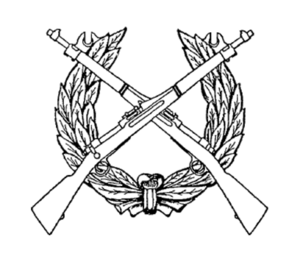Combat Action Badge: Difference between revisions
| Line 42: | Line 42: | ||
* [[Pequeñoyan Emergency]] (1958) | * [[Pequeñoyan Emergency]] (1958) | ||
* [[Operation Firefly]] (1985 - 1986) | * [[Operation Firefly]] (1985 - 1986) | ||
* [[Terrican Emergency]] (1990 - 1997) | |||
* [[1997 Sable Conflict]] (1997) | * [[1997 Sable Conflict]] (1997) | ||
* [[Terrican Emergency|Second Terrican Emergency]] (2004 - 2014) | * [[Terrican Emergency|Second Terrican Emergency]] (2004 - 2014) | ||
* [[Operation Implicit Resolve]] (2014 - Present) | * [[Operation Implicit Resolve]] (2014 - Present) | ||
Revision as of 02:07, 10 May 2019
| Combat Action Badge | |
|---|---|
 An Aisling Combat Action Badge | |
| Awarded by | |
| Eligibility | An active duty or reserve member of the Armed Forces of the Temuair Empire of the rank of Colonel or below who is assigned to an infantry or special forces military occupational specialty. |
| Awarded for | Awarded to members of the Armed Forces who have been engaged by the enemy and/or engaged enemy forces in ground or surface combat. The engagement must have presented a certain risk of grave bodily harm for a recipient to qualify. |
| Status | Currently Awarded |
| Statistics | |
| Established | 1 January, 1942 |
| Precedence | |
| Next (higher) | None |
| Equivalent | Combat Action Ribbon Aviation Combat Badge |
| Next (lower) | None |
The Combat Action Badge, sometimes shortened to CAB, is an award issued by the Armed Forces of the Temuair Empire to any member of the armed forces assigned to an infantry or special forces occupational specialty who has participated in active ground combat against enemy forces, and in doing so, was exposed to the potential of grave bodily harm.
History
The Combat Action Badge was approved by Emperador Neira III in 1942 during the Third Peninsular War. Though the Imperial military had already authorized the Combat Action Ribbon as early as 1850 and had awarded it to any member of the armed forces who participated in direct combat, the Combat Action Badge was envisioned as a way to recognize the inherent sacrifices of all infantrymen, and that they face a greater risk of being wounded or killed in action than any other military occupational specialties.
Though the military's order of precedence regarding awards states that the Combat Action Badge and the Combat Action Ribbon are equivalent, it is generally held that a Combat Action Badge is more prestigious than its counterpart, leading to some friction between infantrymen and other combat arms such as armor and artillery. This has been especially prevalent since the introduction of the Aviation Combat Badge in 1990.
Eligibility requirements
A member of the Imperial Armed Forces must meet the following three requirements to be awarded the Combat Action Badge:
- Be an infantryman satisfactorily performing infantry duties.
- Be assigned to an infantry unit during such time as the unit is engaged in active ground combat.
- Actively engage the enemy in ground combat and be at risk of grave bodily harm.
Because the recipient must be assigned to an infantry or special forces occupational specialty, the Combat Action Badge tends to only be awarded to members of the Imperial Army of Temuair, though members of other branches can qualify for it, such as members of the Imperial Air Force's Olheiros or the Imperial Navy of Temuair's Naval Infantry forces. Members of the armed force who are not considered to be infantry or special forces receive the Combat Action Ribbon.
Combat Action Badge can be awarded multiple times, once for each eligible deployment and contact with the enemy. It cannot be awarded in conjunction with the Combat Action Ribbon. If a recipient of the Combat Action Ribbon later earns a Combat Action Badge, it is worn in place of the Combat Action Ribbon. If a recipient of the Combat Action Badge changes occupational specialties and meets the qualifications for the Combat Action Ribbon after doing so, no award is issued.
Qualifying conflicts and periods
- Third Peninsular War (1937 - 1946)
- Fourth Peninsular War (1955 - 1960)
- Pequeñoyan Emergency (1958)
- Operation Firefly (1985 - 1986)
- Terrican Emergency (1990 - 1997)
- 1997 Sable Conflict (1997)
- Second Terrican Emergency (2004 - 2014)
- Operation Implicit Resolve (2014 - Present)
